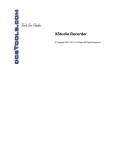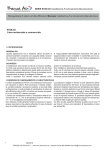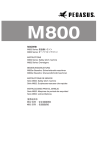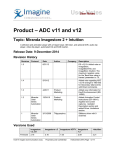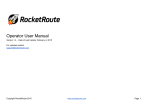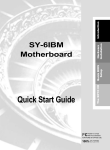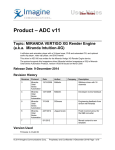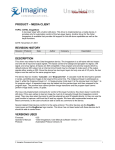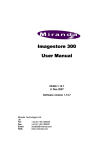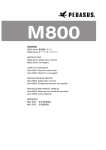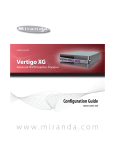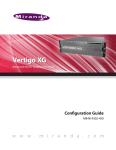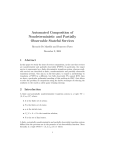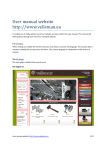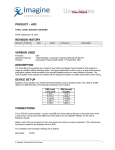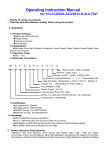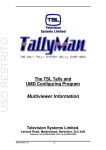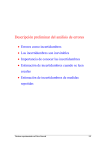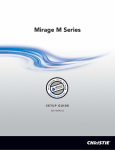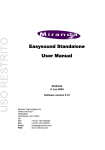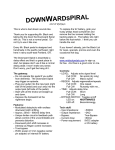Download After Effects Plug
Transcript
USO RESTRITO After Effects Plug-in User Manual M852-1200-500 Copyright & Trademark Notice Copyright © 2015, Grass Valley USA, LLC. All rights reserved. USO RESTRITO Belden, Belden Sending All The Right Signals, and the Belden logo are trademarks or registered trademarks of Belden Inc. or its affiliated companies in the United States and other jurisdictions. Grass Valley USA, LLC, Miranda, Vertigo Suite, Vertigo XG and Xmedia Server are trademarks or registered trademarks of Grass Valley USA, LLC. Belden Inc., Grass Valley USA, LLC, and other parties may also have trademark rights in other terms used herein. Terms and Conditions Please read the following terms and conditions carefully. By using the After Effects Plug-in documentation, you agree to the following terms and conditions. Grass Valley hereby grants permission and license to owners of the Vertigo Suite to use their product manuals for their own internal business use. Manuals for Grass Valley, A Belden Brand products may not be reproduced or transmitted in any form or by any means, electronic or mechanical, including photocopying and recording, for any purpose unless specifically authorized in writing by Grass Valley. A Grass Valley manual may have been revised to reflect changes made to the product during its manufacturing life. Thus, different versions of a manual may exist for any given product. Care should be taken to ensure that one obtains the proper manual version for a specific product serial number. Information in this document is subject to change without notice and does not represent a commitment on the part of Grass Valley. Warranty Policies Warranty information is available in the Support section of the Grass Valley Web site (www.grassvalley.com). Document Identification Title After Effects Plug-in User Manual Part number M852-1200-500 SW version Vertigo Suite v5.0 Revision History USO RESTRITO After the original release date, the After Effects Plug-in User Manual may be updated with edits and then re-released. The following table tracks the versions of this document. Revision date Description November 28, 2014 Original release March 02, 2015 Vertigo Suite v5.0 SP1 release TABLE OF CONTENTS Introducing the Vertigo After Effects Plug-in .................................................................... 1-1 Installing Vertigo After Effects Plug-in ............................................................................................... 1-2 USO RESTRITO Vertigo Animation option .................................................................................................... 2-1 Using the Vertigo Animation option ................................................................................................... 2-2 Export Options panel ......................................................................................................................... 2-3 Oxtel Export tab ............................................................................................................................ 2-4 VAF Export tab ............................................................................................................................. 2-6 HMP MXF Export tab .................................................................................................................... 2-7 Logging tab ................................................................................................................................... 2-8 Vertigo Animation (Merge Mode) option............................................................................ 3-1 Workflow for pre-rendering in-show promos using the After Effects Plug-in ..................................... 3-2 Using the Merge Mode option to perform a batch export of graphics files ........................................ 3-3 Creating a spreadsheet for Merge Mode ........................................................................................... 3-5 Project Name column ................................................................................................................... 3-5 Output File Name column ............................................................................................................. 3-6 Subfolder columns ........................................................................................................................ 3-7 Layer tag columns ........................................................................................................................ 3-9 Intuition Template & Intuition Template Element columns.......................................................... 3-10 Asset Lifespan column................................................................................................................ 3-10 Asset Expiry Date column........................................................................................................... 3-10 Vertigo Template, Vertigo Template Element & VAF XmediaServer columns ........................... 3-11 Handling a Project with Multiple Compositions ........................................................................... 3-12 Transcoding TGA sequences into animation and/or video files....................................................... 3-13 After Effects Plug-in User Manual TOC-1 USO RESTRITO Table of Contents TOC-2 After Effects Plug-in User Manual USO RESTRITO 1 INTRODUCING THE VERTIGO AFTER EFFECTS PLUG-IN The Vertigo After Effects Plug-in uses base After Effects projects to pre-render graphics into animation or video clip files that can then be used on a variety of playout devices. • • • • .oxi - OXI animation files for Intuition Classic devices .oxa - OXA animation files for Imagestore 750 and LGK -3901 devices .vaf - VAF video clip files for Intuition XG and Vertigo XG devices .mxf - MXF video clip files for HMP-1801 devices N OTE The After Effects Plug-in can also embed a .VAF inside an .OXI or .OXA file by enabling a setting within the Oxtel Export Options in Merge Mode. This allows the asset to be used on Intuition Classic, Intuition XG, and Vertigo XG devices. See “Embed VAF in OXI” on page 2-5. The Affects Effects Plug-in consists of two (2) options for rendering graphics files from an After Effects project: • Vertigo Animation - The VERTIGO ANIMATION option is the basic mode that simply uses the currently loaded After Effects project to generate and save the After Effects project as an animation or video file. See page 2-1 for further instructions and information. • Vertigo Animation (Merge Mode) - The MERGE MODE option allows you to prepare multiple versions of graphics by using traffic data from an Excel spreadsheet to feed an Adobe After Effects Project template. The plug-in then combines the data and the template to generate multiple versions of the promo, as animation or video files, for different channels, days and times. In addition to creating animation and video files, Merge Mode also allows you to output an Intuition template with the newly created animation inserted based on an original Intuition template. Another practical use of the Merge Mode option is to transcode Targa (TGA) sequences from disk to OXI/OXA animations and/or VAF video clip format. See “Vertigo Animation (Merge Mode) option” on page 3-1 for further instructions and information. After Effects Plug-in User Manual 1-1 Introducing the Vertigo After Effects Plug-in Installing Vertigo After Effects Plug-in The After Effects Plug-in is packaged with the Vertigo Suite software’s installation wizard. It can be installed as part of the full installation or as an individual (standalone) component. In both cases, you simply need to run the installation wizard on the workstation where the Adobe After Effects software is installed. USO RESTRITO N OTE 1-2 The After Effects Plug-in for CS3 and CS4 is only available from the 32-bit version of the Vertigo Suite installer. Similarly, the After Effects Plug-in for CS5, CS5.5 and CS6 are only available in the 64-bit version of the Vertigo Suite installer. Once the After Effects Plug-in is installed, start the Adobe After Effects application and then load or create a new After Effects project. To verify that the Vertigo After Effects Plug-in has been installed and is present in the After Effects application: 1. Select the FILE>EXPORT menu command. 2. Confirm that both the VERTIGO ANIMATION and VERTIGO ANIMATION (MERGE MODE) commands are displayed. N OTE The Vertigo Animation command will be disabled (gray) until a valid After Effects project is loaded and a composition is selected. The first time that you run the After Effects Plug-in, you will be prompted for a license code. Please contact our Technical Support representative to request an After Effects Plug-in license code. N OTE When running Adobe After Effects and the Vertigo After Effects Plug-in on Windows 7, you must be logged on as Administrator. After Effects Plug-in User Manual USO RESTRITO 2 VERTIGO ANIMATION OPTION The Vertigo After Effects Plug-in’s VERTIGO ANIMATION option is the basic mode that uses the currently loaded After Effects project to generate an animation or video clip file. The resulting file can then be saved to a specified directory as one of the following formats: OXI, OXA, VAF, or MXF. The following sections provide instructions for using the VERTIGO ANIMATION option, as well as descriptions of each of the Export options that are available: • “Using the Vertigo Animation option” on page 2-2 • “Export Options panel” on page 2-3 After Effects Plug-in User Manual 2-1 Vertigo Animation option Using the Vertigo Animation option USO RESTRITO To use the Vertigo Animation option to generate an animation or video clip file: 1. Start the Adobe After Effects application. 2. Load or create a new After Effects project. 3. Select the FILE>EXPORT>VERTIGO ANIMATION menu command. The EXPORT VERTIGO ANIMATION dialog box appears, which allows you to select the output file path and the type of file to be exported. N OTE If the VERTIGO ANIMATION option is greyed out, load a valid After Effects project and select a composition. 4. Specify the OUTPUT FILE PATH in which you want to save the animation or video file: a. Click the Browse button to open the EXPORT ANIMATION dialog box. b. Navigate to the directory location where you want to save the animation or video file. c. In the FILE NAME field, specify the name by which the file is to be saved. d. Select from the SAVE AS TYPE drop-down list, the desired animation or video clip file type. The suffix at the end of the file name defines the type of file to be exported. Choose one of the following file types: OXTEL OXI FILE (*.oxi) Exports an animation file for Intuition Classic devices (default) OXTEL OXA (*.oxa) Exports an animation file for Imagestore and LGK devices VERTIGO ANIMATION FILE (*.vaf) Exports a video clip file for Intuition XG and Vertigo XG devices MATERIAL EXCHANGE FORMAT (*.mxf) Exports a video clip file for HMP-1801 devices 2-2 e. Click SAVE. 5. Select the OPTIONS button to expose advanced options, which specify how the animation or video file will be created, including desired looping behaviors. See “Export Options panel” on page 2-3 for more information. 6. Launch the creation of the animation or video file by clicking OK. The EXPORT VERTIGO ANIMATION dialog box closes, while the EXPORT PROGRESS dialog box appears and tracks the progress of the procedure. Once finished, the file is saved to the specific directory location. After Effects Plug-in User Manual Vertigo Animation option Export Options panel The Export Options panel allows you to specify how the OXI, OXA or VAF files will be created. As well, the Logging tab allows you to record the plug-in’s rendering activities into a log file. Note that any changes made to the Export Options panel’s settings are saved, so they only need to be modified as required. USO RESTRITO The Export Options panel is organized into three (3) thematic tabs: OXTEL EXPORT, VAF EXPORT and LOGGING. The following sections identify and describe the options on each of the Export Options panel’s tabs: • “Oxtel Export tab” on page 2-4 • “VAF Export tab” on page 2-6 • “Logging tab” on page 2-8 After Effects Plug-in User Manual 2-3 Vertigo Animation option Oxtel Export tab USO RESTRITO The Oxtel Export tab (figure 2-1) exposes a series of advanced settings which affect the way in which the After Effects Plug-in renders OXI and OXA animation files based upon an After Effects project. Figure 2-1. The Oxtel Export tab The following table provides descriptions for each of the parameters on the Oxtel Export tab. Export as Video Standard 2-4 • • FIELDS (COMPOSITIONS ONLY): When set to FIELDS, each frame from the After Effects project is split into two fields in the final animation. FRAMES: When set to FRAMES, each frame becomes either an individual field (when creating an interlaced file), or a whole frame (in a progressive standard). When outputting to a progressive standard, this setting will be ignored and each frame will always be treated as a frame. Specifies the resolution format that will be used when the animation file is rendered. Choose from the following settings: • PAL (720x576) • NTSC (720x486) • 720p (1280x720) • 1080i (1920x1080) • 1080p (1920x1080) After Effects Plug-in User Manual Vertigo Animation option The frame rate option for TGA sequences dictates the frame rate that will be written into the animation file. Since there is no way to store a frame rate with a TGA sequence, it must be specified manually in this parameter. USO RESTRITO Frame Rate (for TGA Sequence on Disk) The possible settings are dependent upon the Video Standard specified: • PAL = 25 • NTSC = 30M • 720p = 60, 60M, 50 • 1080i = 30, 30M, 25 • 1080p = 60, 60M, 50 Pixel Aspect Ratio Specifies the Pixel Aspect Ratio format that will be used when rendering the animation. Choose from the following settings: • Square Pixels • Standard TV (4x3) • Widescreen (16x9) Embed VAF in OXI Specifies whether or not to embed the VAF payload inside the .OXI or .OXA file. Embedding the VAF allows for the same asset to be used on the Intuition classic, Intuition XG, and Vertigo XG. • Don’t embed VAF • Embed VAF in OXI/OXA file Thumbnail frame This is the frame index from which the thumbnail proxy will be generated. Looping Loop Mode - Choose from among the following settings to specify the animation’s loop behavior during playout. • Cycle: The animation file will play through until the end is reached and then loop back to the start of the animation. • Single Shot: The animation file will be replayed just once through. • Ping Pong: The animation plays forward and then returns in reverse. • In Loop Out: The animation will play to the End Frame as defined in the dialog then jump back to the Start Frame and then keep looping between these two frames. • Linear Control: Use this setting when the animation’s playback is controlled by automation commands. Clipping The following settings remove the empty parts of the animation frame (e.g. the black areas around the edges of each frame). This is helpful as it reduces the file size, though it takes longer for the plug-in to process each frame. • Clip frames: Clips any solid transparent areas of the animation frame. • Key garbage level: This setting only needs to be changed from the default of 0 if the source material being used to generate the animation contains noise which is interpreted as part of the image. A setting above 0 creates a threshold below which any noise is ignored. The actual garbage level setting required depends on how much noise is included in the source material and the appropriate level can only be found through experimentation. After Effects Plug-in User Manual 2-5 Vertigo Animation option VAF Export tab USO RESTRITO The VAF Export options (figure 2-2) exposes a series of advanced settings which affect the way in which the After Effects Plug-in renders VAF video clip files based upon an After Effects project. Figure 2-2. The VAF Export tab The following table provides descriptions for each of the parameters on the VAF Export tab. Same as Oxtel Export Settings Frame Rate (For TGA Sequence on Disk) Looping 2-6 When enabled, this parameter keeps the VAF settings the same as the OXI/OXA settings. Note that the loop settings between OXI/OXA and VAF are different. We interpret them as follows: • OXI CYCLE = VAF Loop Entire Animation • OXI SINGLE SHOT = VAF Single Shot • OXI PING PONG = VAF Loop Entire Animation • OXI INLOOPOUT = Loop Range user set start frame to user set end frame • OXI LINEAR CONTROL = VAF Single Shot The frame rate option for TGA sequences dictates the frame rate that will be written into the video file. Since there is no way to store a frame rate with a TGA sequence, it must be specified manually in this parameter. Choose one of the following settings: 25, 30M, 30, 50, 60M or 60. Loop Mode - Choose from among the following settings to specify the animation’s loop behavior during playout. • Single Shot: The video is played just once through. • Loop Entire Animation: The video plays in its entirety, then restart from the beginning. • Loop Range: The video plays to the End Frame as defined in the dialog then jump back to the Start Frame and then keep looping between these two frames. After Effects Plug-in User Manual Vertigo Animation option HMP MXF Export tab USO RESTRITO The HMP MXF EXPORT tab (figure 2-3) exposes the following advanced parameters which affect the way in which the After Effects Plug-in renders MXF video clip files that are used by HMP-1801 devices. Figure 2-3. The HMP MXF EXPORT tab was added to the After Effects Plug-in Export Options panel Loop Enables or disables the looping of the MXF file’s playout. The number of loops performed is set by the LOOP COUNT parameter. Loop Count Specifies the number of times the rendered video clip will be looped. The default value is 0. Video Fade In (frame) Specifies the number of frames (duration) that it takes for the video to fade-in on initial playout. The default value is 0 frames. Video Fade Out (frame) Specifies the number of frames (duration) that it takes for the video to fade-out to the ending of playout. The default value is 0 frames. Video Hold First (frame) Specifies the time (in number of frames) to hold on the first frame of data. The default value is 0 frames. Video Hold Last (frame) Specifies the time (in number of frames) to hold on the last frame of data. The default value is 0 frames. After Effects Plug-in User Manual 2-7 Vertigo Animation option Logging tab As the After Effects Plug-in operates, AE Plugin events are recorded to a log text file, which is stored in the following directory location: C:\Documents and Settings\All Users\Application Data\VertigoXmedia\Logs USO RESTRITO Every execution of the After Effects Plug-in appends to the most recent AEPlugin log file until it reaches the size specified in the LOGFILE SIZE setting at which point it will rollover and create a new file. 2-8 The Logging tab (figure 2-4) features two settings to control the size and number of the log files stored: • Rollover count - The rollover count determines the number of AEPlugin*.log files are kept in the logging folder. Choose a large enough number so that enough relevant log files are stored. This helps to identify of repetitive behaviors and facilitates troubleshooting. • Log file size - The maximum size of a log file before starting over from the beginning. The value specified in bytes. Figure 2-4. The Logging tab After Effects Plug-in User Manual 3 VERTIGO ANIMATION (MERGE MODE) USO RESTRITO OPTION Graphics which must be prepared in multiple versions, like in-show promos, can be prepared more quickly and more accurately using the After Effects Plug-in’s VERTIGO ANIMATION (MERGE MODE) option. The process uses traffic data in a spreadsheet to feed an Adobe After Effects Project composition. The plug-in combines the data and the composition to generate multiple versions of the promo, as animation or video files, for different channels, days and times. This approach allows quality control tasks to be performed quickly and easily. The following sections describe the workflow and provide instructions for using the VERTIGO ANIMATION (MERGE MODE) option to render multiple versions of in-show promotional graphics: • “Workflow for pre-rendering in-show promos using the After Effects Plug-in” on page 3-2 • “Using the Merge Mode option to perform a batch export of graphics files” on page 3-3 • “Creating a spreadsheet for Merge Mode” on page 3-5 N OTE By default, Vertigo After Effects Plug-in renders the first composition in a project. See “Handling a Project with Multiple Compositions” on page 3-12 for more information. The Vertigo Animation (Merge Mode) option also allows you to generate an Intuition template for each exported animation containing the new animation file (the new template is based on a specified pre-existing template file). See page 3-10 for more information. Another practical use of the VERTIGO ANIMATION (MERGE MODE) option is to transcode Targa (TGA) sequences from disk to OXI/OXA animations and/or VAF video clip format. See “Transcoding TGA sequences into animation and/or video files” on page 3-13 for more information. After Effects Plug-in User Manual 3-1 Vertigo Animation (Merge Mode) option Workflow for pre-rendering in-show promos using the After Effects Plug-in USO RESTRITO Figure 3-1 demonstrates the workflow for pre-rendering in-show promos using the After Effects Plug-in. 3-2 Figure 3-1. Workflow for pre-rendering in-show promos using the After Effects Plug-in 1. 2. 3. 4. 5. Graphics templates are created using Adobe After Effects on a graphics workstation, equipped with the Vertigo After Effects Plug-in. The full range of After Effects text effects can be used for the graphics because they will be flattened before playout. The operator opens an Excel spreadsheet from the traffic or promo department, which lists the details about the promos required, including the template to be used, the onair dates and times, and the show names. The file names are also provided for effective integration with the station’s playout automation. The Vertigo After Effects Plug-in extracts the data from the spreadsheet and creates a preview of the rendered graphics for quality control. After quality control, the workstation automatically renders all of the promos, and generates flattened files. The completed graphics are then transferred to a Vertigo Xmedia Server for archiving, or directly to a channel branding processor for playout under automation. After Effects Plug-in User Manual Vertigo Animation (Merge Mode) option USO RESTRITO Using the Merge Mode option to perform a batch export of graphics files To use the Vertigo Animation (Merge Mode) option to generate a batch export of animation and/or video clip files from an After Effects project: 1. Create a base template for the graphics using the After Effects application. 2. Create an Excel spreadsheet that contains the proper formatting and information to feed the template and create multiple animation and/or video files. See “Creating a spreadsheet for Merge Mode” on page 3-5 for more information. 3. Select the FILE>EXPORT>VERTIGO ANIMATION (MERGE MODE) menu command. A message appears warning you that the project you currently have open will be closed without saving. To continue, simply click OK. The EXPORT VERTIGO ANIMATION dialog box appears. 4. Click the Browse button in the INPUT - DATA SOURCE FILE NAME field to navigate to and select an Excel spreadsheet, which contains the information for a batch export. Each animation file that is to be created can contain different information which can be extracted from an Excel spreadsheet. This information can replace tags within the project file during the batch process. These tags relate to layers which can contain text, images or clips for replacement. Layers are the basic elements of an After Effects composition and each layer can only include one footage item as its source. See “Creating a spreadsheet for Merge Mode” on page 3-5 for more information about creating an appropriate spreadsheet. 5. Specify an Output destination where the animation and/or video files will be saved to. to • EXPORT TO DIRECTORY - Enable and then click the Browse button navigate to and select the directory in which to save the output files. • EXPORT TO XMS SERVER NAME / IP - Enable and then type either the Xmedia Server’s hostname or the IP address of the XMS device where the output files will be ingested into. 6. Enable OVERWRITE EXISTING FILES / ASSETS if you wish to automatically replace an existing file that may already exist using the exact same name in the exact same location. 7. Select the OPTIONS button to expose advanced options, which specify how the animation and video files will be created, including specifying the looping behavior. See “Export Options panel” on page 2-3 for more information. 8. To ensure that the animation and video files are generated correctly, you can scrub the animation or video before you generate the files and templates (if there are any setup). To preview an animation or video: a. Click the PREVIEW button and the EXPORT VERTIGO ANIMATION dialog box expands to expose the MERGE PREVIEW section. b. To preview each of the animations or videos that will be created in the merge process, click the or buttons or use the a slider to scrub through the resulting files. After Effects Plug-in User Manual 3-3 Vertigo Animation (Merge Mode) option c. 9. If you choose not to process any of the animations or videos, press the REJECT button. REJECTED is then displayed in the lower-right corner of the Merge Preview section and when the batch process is started this file will not be generated. Create the animation and/or video clip files by clicking OK. The EXPORT VERTIGO ANIMATION dialog box closes and the EXPORT PROGRESS dialog box appears to track the animations’ creation. USO RESTRITO N OTE 3-4 If errors occur while generating the exported animation files, an error message appears and offers you the opportunity to see specifically what caused the export to fail. Use these details to troubleshoot. After Effects Plug-in User Manual Vertigo Animation (Merge Mode) option Creating a spreadsheet for Merge Mode USO RESTRITO Before Merge Mode can create a batch export of animation and/or video files, you must create and populate an Excel spreadsheet containing the proper formatting and information (figure 3-2). Figure 3-2. Example of a spreadsheet formatted for merge mode The first row in the spreadsheet contains column headers for the data in the After Effects composition. After the first row of headers, all subsequent valid rows will create an animation or video file using the data specified in the row. The following sections describe the mandatory and optional columns and information that must be present in the spreadsheet for Merge Mode to function properly: • “Project Name column” on page 3-5 (required) • “Output File Name column” on page 3-6 (required) • “Subfolder columns” on page 3-7 (optional) • “Layer tag columns” on page 3-9 (optional) • “Intuition Template & Intuition Template Element columns” on page 3-10 (optional) • “Asset Lifespan column” on page 3-10 (optional) • “Asset Expiry Date column” on page 3-10 (optional) • “Vertigo Template, Vertigo Template Element & VAF XmediaServer columns” on page 3-11 (optional) Project Name column When using the Merge Mode to perform a batch export of animation and/or video files, the first column in the spreadsheet must be named PROJECT NAME. This column must contain the entire path to the After Effects project to be loaded for the given row of data (figure 3-3). Figure 3-3. Example of the Project Name column for exporting a batch of animation files Figure 3-3 also demonstrates that different projects can be associated with each row of a spreadsheet so that animations and/or videos generated from the data in one spreadsheet can be created from different projects. After Effects Plug-in User Manual 3-5 Vertigo Animation (Merge Mode) option Also note that once the project name is specified, all subsequent blank rows will use the same project file until another file is specified (e.g. rows 3 and 4 will both use project 2). USO RESTRITO When using the Vertigo Animation Merge Mode option to transcode Targa (TGA) sequences, the first column in the spreadsheet must still be named PROJECT NAME, but it must contain the entire path to the first frame of the Targa sequence on disk (figure 3-4). See “Transcoding TGA sequences into animation and/or video files” on page 3-13 for more information. Figure 3-4. Example of the Project Name column for transcoding TGA Sequences Output File Name column The second column in the spreadsheet must be named OUTPUT FILE NAME. This column specifies the name and file format of the animation and/or video clip that will be created during the batch export (figure 3-5). Figure 3-5. Example of the second column in the spreadsheet required for Merge Mode The suffix of the file name specifies the type of animation or video file to be created. Valid file types are: • .vaf - VAF animation files for Intuition XG and Vertigo XG devices • .oxi - OXI animation files for Intuition Classic devices • .oxa - OXA animation files for ImageStore 750 and LGK -3901 devices • .mxf - MXF video files for HMP-1801 devices N OTE The After Effects Plug-in can also embed a .VAF inside an .OXI or .OXA file by enabling a setting within the Oxtel Export Options. This allows the asset to be used on Intuition Classic, Intuition XG, and Vertigo XG devices. See “Embed VAF in OXI” on page 2-5. By default, the animation or video file is saved to the location (directory or XMS) specified in the OUTPUT field of the EXPORT VERTIGO ANIMATION dialog box (see page 3-1). If, however, the file is required to be saved into a different directory, this can be specified either in a directory relative to the OUTPUT DIRECTORY, or as an absolute path. Figure 3-6 3-6 After Effects Plug-in User Manual Vertigo Animation (Merge Mode) option USO RESTRITO demonstrates that specifying the relative path Animation\3001.oxi, the animation will be saved to the directory c:\AE\Animation. Meanwhile, specifying the absolute path of c:\AEAnimationFile\3001.oxi saves the file in the folder AEAnimationFile at the root level of c:. Path relative to location specified in the OUTPUT field Absolute path Figure 3-6. Example of the second column in the spreadsheet required for Merge Mode N OTE You can automatically publish the newly rendered animation or video files to the appropriate devices by selecting the appropriate devices within the category or subcategory properties in the Asset Browser (Xplorer or Xstudio). Subfolder columns By default, the rendered animation or video files are saved to the location (directory or XMS) specified in the OUTPUT field of the EXPORT VERTIGO ANIMATION dialog box (see page 3-1). As an alternative method to specifying a relative path in the OUTPUT FILE NAME column (page 3-6), you can also determine exactly where the files will be stored by adding optional SUBFOLDER X columns to the spreadsheet. The Subfolder columns allow you to specify the name and hierarchy of the directory subfolders or XMS subcategories in which to save the file. Subfolder columns must be sequentially numbered starting with SUBFOLDER 1. Figure 3-7 demonstrates that Subfolder columns must be sequentially numbered starting with SUBFOLDER 1 (one-level below the directory location specified in the OUTPUT field or the XMS’s root category. Each additional Subfolder column creates a subdirectory/subcategory below the previous. Also note that the relative path specified in the OUTPUT FILE NAME column (page 3-6), is conserved and applied last. You can also add multiple subdirectories/subcategories in one subfolder column (e.g. cat1\cat2). Figure 3-7. Subfolder columns After Effects Plug-in User Manual 3-7 Vertigo Animation (Merge Mode) option N OTE USO RESTRITO You can automatically publish the newly rendered animation or video files to the appropriate devices by selecting the appropriate devices within the category or subcategory properties in the Asset Browser (Xplorer or Xstudio). 3-8 After Effects Plug-in User Manual Vertigo Animation (Merge Mode) option Layer tag columns Merge Mode allows you to generate multiple versions of a promo for different channels, days and times by substituting the text, image, or clip associate with a layer in the After Effects project and then rendering each variation as a separate as animation or video file. USO RESTRITO To make layer substitutions, you must first be sure that the layer name in the After Effects project must contain the tag name. Figure 3-8 demonstrates that the layer’s tag name in the After Effects project must be preceded with < and followed by a />. To rename a layer in After Effects, select the layer and press the ENTER key. This allows you to rename the layer. Figure 3-8. Tag names for the layers in the After Effects project Once the layer names in the After Effects project contain the properly formatted tag names, you can add a column for each layer that is to be modified. The column headings must be identically named to the tag names given to the layers in the After Effects project, but without the < and />. Each row after the header row should contain the information that will replace the current content of the layer tag. Figure 3-9 demonstrates that the spreadsheet contains four (4) layer tag columns and that the first animation rendered will feature the following substitutions: • • • • <NextShowDay/> will be replaced by Monday <NextShowTime/> will be replaced by 5:00pm <NextShowName/> will be replaced by Les Papous <Image/> will be replaced by ‘V001.tga’ Figure 3-9. Layer tag columns N OTE When replacing an image or a clip, the complete path to the graphic needs to be specified. There can be as many columns of layer tags as required, but they must be from the third column onwards. When replacing a clip, the animation plays out the clip for the duration of the composition. After Effects Plug-in User Manual 3-9 Vertigo Animation (Merge Mode) option Intuition Template & Intuition Template Element columns USO RESTRITO Merge Mode allows you to automatically take an existing base Intuition template and substitute the animation within this template with the newly created Intuition animation file. Figure 3-10 demonstrates that this is accomplished by adding two optional columns to the spreadsheet: INTUITION TEMPLATE and TEMPLATE ELEMENT. Figure 3-10. Intuition Template and Template Element columns The INTUITION TEMPLATE column defines the path to the base template from which the new template will be created. The TEMPLATE ELEMENT column specifies the name of an existing animation entry in the base template that the newly created animation will replace. The newly created template will be saved in the same directory as the animation file that has been created and will be saved with the same name as the output animation file (as a .tem file). The templates are also ingested into the XMS and converted to scenes. Asset Lifespan column Adding an optional ASSET LIFESPAN column to the spreadsheet allows you to set the publish lifespan of each animation or video file created by the After Effects Plug-in’s Merge Mode. The value is specified in days that must elapse since the last time the new file has been accessed before it is removed from the published device. This does not remove it from the Xmedia Server. If the entry for a specific row is empty, then the Xmedia Server assigns the default lifespan of 365 days. Asset Expiry Date column 3-10 Adding an optional ASSET EXPIRY DATE column to the spreadsheet allows you to set the date of when the new animation or video file is to be deleted from the Xmedia Server. The format for this setting must be M-D-YYYY. After Effects Plug-in User Manual Vertigo Animation (Merge Mode) option Vertigo Template, Vertigo Template Element & VAF XmediaServer columns USO RESTRITO The following columns in the Merge List file (.xls) allow the VAF portion of a OXI-Embedded VAF to be ingested into specified Xmedia Servers, while the After Effects Plug-in is generating the OXI-Embedded VAF. • Vertigo Template: Specifies the name and location of the base Template that the VAF uses when loaded on the XG playout devices. This template must exist on the Main and Backup Xmedia Servers. • Vertigo Template Element: Specifies the name of the template element that holds the VAF when the template is loaded. • Vertigo Template Element: A comma separated list of Xmedia Server IPs or names that represent where the target Xmedia Servers are defined. Note that the VAF that is ingested into the Xmedia Servers with the same name as the OXIEmbedded VAF and it will be added as a clip asset in the root of the CLIPS category. Also, a Page is created based of the base template specified in the VERTIGO TEMPLATE column of the .xls Merge List. This Page has the same name as the VAF and is categorized in the root of the PAGES category. After Effects Plug-in User Manual 3-11 Vertigo Animation (Merge Mode) option Handling a Project with Multiple Compositions USO RESTRITO It is possible to generate an animation file from a project containing multiple compositions. Elements within any composition can be substituted. Additionally, the composition that the operator wishes to render can be specified. Figure 3-11 provides an example of the modified spreadsheet to support multiple compositions. 3-12 Figure 3-11. Rendering an animation file from a specific AE composition The RENDER COMPOSITION column specifies which composition within the project will be rendered by the After Effects Plug-in. If this column is not included, the first (default) composition for the project will be rendered. To specify an element within a composition to substitute, the format of the column header must be ‘COMPOSITION NAME|ELEMENT NAME’. For example, COMP1|NEXTSHOWTIME. If only the element name is entered, then the substitution will take place on an element in the composition specified within RENDER COMPOSITION column, or within the default composition if this is not specified. For example, figure 3-11 shows that the first substitution will take place in the composition called COMP1 and it will look for an element named NEXTSHOWTIME. After Effects Plug-in User Manual Vertigo Animation (Merge Mode) option Transcoding TGA sequences into animation and/or video files USO RESTRITO Merge Mode can also be used to transcode Targa (TGA) sequences into OXI /OXA animation file and/or VAF video clip files. The newly created files can then be saved either to disk or ingest into an Xmedia Server, which can then be configured to automatically publish the assets to a playout device. Figure 3-12 demonstrates that the entire path to the first frame of the Targa sequence on disk must be specified in the spreadsheet’s PROJECT NAME column. Meanwhile, the name and file type of the desired animations or video clips must be specified in the OUTPUT FILE NAME column. Figure 3-12. Transcoding Targa sequences into clip and/or cel animation assets To use the Vertigo Animation (Merge Mode) option to transcode TGA sequences into OXI, OXA, or VAF files: 1. Create and save an Excel spreadsheet that has a minimum of the two (2) columns: • PROJECT NAME: Specify the entire path to the first frame of the Targa sequence on disk. • OUTPUT FILE NAME: Specify the name and file type (.oxi, .oxa, or .vaf) of the desired animations or video clips. 2. Start the Adobe After Effects application. 3. Select the FILE>EXPORT>VERTIGO ANIMATION (MERGE MODE) menu command. A message appears warning you that the project you currently have open will be closed without saving. To continue, simply click OK. The EXPORT VERTIGO ANIMATION dialog box appears. 4. Click the Browse button in the INPUT - DATA SOURCE FILE NAME field to navigate to and select the Excel spreadsheet created in step 1. 5. Specify an Output destination where the animation files will be saved to. to • EXPORT TO DIRECTORY - Enable and then click the Browse button navigate to and select the directory in which to save the output files. • EXPORT TO XMS SERVER NAME / IP - Enable and then type either the Xmedia Server’s hostname or the IP address of the XMS device where the output files will be ingested into. 6. Enable OVERWRITE EXISTING FILES / ASSETS if you wish to automatically replace an existing video file that may already exist using the exact same name in the exact same location. 7. Select the OPTIONS button to expose advanced options, which specify how the animation and video files will be created. For example, you can specify your After Effects Plug-in User Manual 3-13 Vertigo Animation (Merge Mode) option USO RESTRITO 8. 3-14 9. animation’s looping settings. See “Export Options panel” on page 2-3 for more information. To ensure that the animation files are generated correctly, you can preview the animation before you generate the files. To preview an animation: a. Click the PREVIEW button and the EXPORT VERTIGO ANIMATION dialog box expands to expose the MERGE PREVIEW section. b. To preview each of the animations that will be created in the merge process, click the or buttons or use the a slider to scrub through the animation. c. If you choose not to process any of the animations, press the REJECT button. Rejected is then displayed in the lower-right corner of the Merge Preview section and when the batch process is started this animation will not be generated. Create the animation and/or video files by clicking OK. The EXPORT VERTIGO ANIMATION dialog box closes and the EXPORT PROGRESS dialog box appears to track the files’ creation. If errors occur while generating the exported animation and/or video files, an error message appears and offers you the opportunity to see specifically what caused the export to fail. Use these details to troubleshoot. After Effects Plug-in User Manual





























